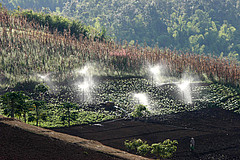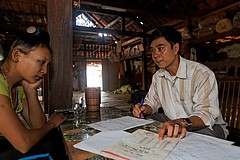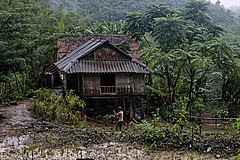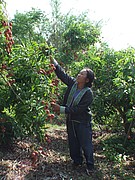Fighting Poverty & Conserving Resources:
Solutions for humanity’s problems are complex - yet possible [18.04.12]
The University of Hohenheim spent 12 years researching the vicious circle of poverty and environmental destruction in Southeast Asia. And achieved practical results.
International Conference of the Collaborative Research Centre 564 begins today in the palace of the University of Hohenheim, 70599 Stuttgart
The ground is fertile: During the course of the next two days, 200 researchers will be formally wrapping up 12 years of intensive problem analysis, innovative developments and contributions towards sustainable development. However, parallel to the completion of the collaborative research centre (SFB), the insights won are already being put into practice. With regards to this, the SFB initiated six transfer projects with the aim of breaking the vicious circle of poverty and the destruction of fragile ecosystems. The projects were developed in the mountainous regions of Thailand and Vietnam. This is a geographic area in which the problems which are faced by the inhabitants bundle and burn like a laser. A typical phenomenon for many other regions on the planet. More information regarding the SFB at: sfb564.uni-hohenheim.de
The starting point of the situation could hardly be any more complex: In the mountainous regions of Thailand and Vietnam a fragile environment finds itself in a head-on collision with social and economic complexities.
Population growth and resettlements are forcing parts of society to farm barren land on mountainsides. Most affected are people who do not live in the economic boom regions and have little or no educational, financial or political opportunity.
Breaks with traditional and appropriate farming techniques are being caused by over-population, political upheaval and globalisation. The erosion is reaching dramatic proportions. New types of crops, such as corn and various other vegetables, are raising the levels of fertiliser and pesticides.
The consequences of this can be felt in the flatlands. The soil run-off is destroying fish ponds and shortening the life-cycle of hydroelectric power plants. Pesticides are collecting in rice paddies and are seeping into the ground water in the flatlands.
A vicious circle typical of all too many regions. The core challenge for future developments is to balance improvements in the quality of life of the population in the mountainous regions against protecting the ecology and preserving the natural resources.
Detailed analysis instead of quick and dirty cure-all recipes
It is a dilemma for which simple solutions are of no use. For that reason, the University founded the Collaborative Research Centre Sustainable Land Use and Rural Development in the Mountainous Regions of Southeast Asia (SFB 564) 12 years ago. Since that time, a multinational network has sprawled. It includes more than 130 scientists from seven research facilities in Germany, Vietnam and Thailand. The project brings together scientists from the fields of soil, agricultural, and nutritional and food science with economists, social science experts and computer programmers and modellers.Together they provided instruction to more than 90 young scientists and dealt in detail with issues in more than 180 international publications. The result: an array of new university partnerships and joint study programmes. Due to the project’s great success, the German Research Foundation extended funding on a number of occasions - up until the absolute limit.
A case study for other regions
The University of Hohenheim expects not only scientists, but also politicians from the participating countries, as well as representatives from the business sector to attend the closing conference. Also expected are scientists working in China, Latin America and Africa hoping to exchange their research experiences in these various regions. Two things have stood at the forefront of the project from the very start: participation from the local inhabitants and the global picture.
The conclusion as new kick-off: science passes the ball on
“The ground is fertile: hand-in-hand with research, we have been involved with the transfer of knowledge and innovation from the very start. “The time has come to force a practical application with all of our might”, says the SFB’s spokesperson, Prof. Dr. Karl Stahr in preparation for the conference. The German Research Foundation stands behind this assessment. For that reason, it will be supporting a number of so-called “transfer projects” until the year 2014. The purpose of these is to extract solutions from research activities. The wide-ranging scope of the project can be illustrated using three examples: going from being a fruit farmer to a fruit processing enterprise, the market breakthrough of pork from traditional and well-adapted breeds of swine among small farmers and new computer models which can be used by scientists to study the economic and ecological impact of new innovations developed by the SFB.
1st example of transfer: from fruit farmer to fruit entrepreneur
Till now, farmers suffered from short seasons, plummeting prices caused by imports, over-production or damage to their goods during harvesting or in transit. Most especially fruit farmers in Thailand. In particular, lychee trees had to make room increasingly for vegetable fields, which led to increases in the amount of erosion, as well as in the use of pesticides.In inter-disciplinary fashion, the SFB developed its own way to assess the quality of lychees, researched harvesting techniques outside of the main season and conducted market research studies regarding consumer opinions, the profit feasibility for premium fruit without the use of pesticides and the possibility to export certified fruit to the EU.The respective technology enables farmers to save water and to add value to their goods by means of drying and the processing of fruit into jam. Together with villages which exemplify the plight of local farmers, the first cooperatives with their own self-sufficient marketing campaigns directed towards the better-paying fruit wholesalers were created.
2nd example of transfer: native mountain swine as cash cow
Quality is a high priority to consumers in Vietnam. As is pork. Over the past few years, the country has gone from being an exporter to an importer of meat. This is an opportunity for small farmers and their native breeds, which are not only easy to breed, but they also deliver very special and very high-quality meat.Based on market research it conducted, the SFB developed a breeding programme for preserving the older breeds in cooperation with local farmers. New advertising strategies were conceived in think tanks, encompassing the production chain- from the small farmers to cooperatives to certified production facilities all the way to slaughterhouses and cities. One of the campaign’s role models: the Schwäbisch-Hällische-Landschwein cooperative.
3rd example of transfer: computer model predicts consequences
Researchers are particularly proud of a series of computer models which create a virtual picture of the mountainous territory. The model takes into account the natural circumstances and plant growth and then adds the human variable. The purpose of the model is to calculate what impact innovation and political measures will have upon the income levels of those living in the mountains, as well as the natural resources in the region.More specifically, the model includes factors such as soil type, soil fertility, topography and the climate, as well as other aspects, such as vegetation and its dependency on the natural surroundings for growth.The human aspect, behaviour, was observed by the team of sociologists in countless interviews and studies. This data was added to the computer model, as well, thus creating a picture of the interplay between nature and entrepreneurial activities. The model also provides information about how farmers utilise their resources, such as land, human resources, livestock and capital - and regardless of financial considerations, whether or not they should plough their land or leave it fallow, burn the remainder of the harvest, apply fertiliser or take measures to protect the soil.Certain criteria can be added to the model, such as price development, political decisions, credit availability and a range of others in order to calculate the impact on the inhabitants and the environment. The ultimate goal is to continue development of the model until a prototype exists which, like a tool, can be used for making political decisions.
University wants to keep network alive
“The Collaborative Research Centre 564 is a success story on which I can only congratulate all who participated”, says the President of the University, Prof. Dr. Stephan Dabbert. He adds that “the top-notch research, the high degree of inter-disciplinary and international collaboration has made the SFB one of the University’s crown jewels.”The University’s executive board is especially proud of the transfer projects in progress, which they believe continue to make vital contributions to research, as well as the active network which, in the meanwhile, extends far beyond Thailand and Vietnam. Prof. Dr. Dabbert concludes “the SFB has given us a network of clever minds and personal contacts which goes beyond academic and political borders. This is an asset to science which must be looked after and maintained.” The origins of the network actually go much further back than 12 years ago when the project was started. “We actually began analysing the problems in the region in the mid 90’s”, Prof. Dr. Franz Heidhues, founder and first spokesperson of the SFB, recollects. “We quickly realised how necessary it is to tackle such a complex problem on different fronts using know-how from different disciplines.”Prof. Dr. Heidhues’ successor and current spokesperson of the SFB, Prof. Dr. Karl Stahr, is certain that this approach, as the success of the project has proved, was the right one.
Text: Klebs, Transl.: O'Mealy
Contact for press:
Prof. Dr. rer. nat. Karl Stahr, Universität Hohenheim, Sprecher des Sonderforschungsbereiches „Nachhaltige Landnutzung und ländliche Entwicklung in Bergregionen Südostasiens“ (SFB 564), Tel.: 0711 459-23981, karl.stahr@uni-hohenheim.de
Dr. rer. nat. Holger Fröhlich, Geschäftsführer des Sonderforschungsbereiches „Nachhaltige Landnutzung und ländliche Entwicklung in Bergregionen Südostasiens“ (SFB 564), Tel.: 0711 459 22574, holger.froehlich@uni-hohenheim.de
Prof. Dr. Franz Heidhues, Universität Hohenheim, Initiator des Sonderforschungsbereiches „Nachhaltige Landnutzung und ländliche Entwicklung in Bergregionen Südostasiens“ (SFB 564), Tel.: 0711 459 22581, heidhues@uni-hohenheim.de








